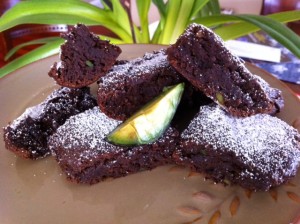By Kristen Rasmussen, MS, RD For this month’s well being challenge, we encourage you to replace an unhealthy saturated fat or refined carbohydrate with a healthy unsaturated fat source once a day for one week. Demonstrate your commitment toembracing healthy fats in your diet by posting photos or comments about your healthy fat substitutions on our Facebook page wall. Here’s a recipe to get you started. Chocolate and Avocado Brownies Makes one 9×13’’ pan Ingredients 1 3/4 cups all-purpose flour 3/4 cup white sugar 3/4 cup brown sugar 3/4 cup unsweetened cocoa powder 1 teaspoon baking powder 3/4 teaspoon salt 1 cup mashed avocado 3/4 cup lowfat cow’s milk or soymilk 2 tablespoons vegetable oil or coconut oil, plus more for greasing baking dish 1 teaspoon vanilla extract To Prepare 1. Preheat oven to 350 degrees F. Lightly grease a 9×13″ baking dish with oil. 2. Mix together the flour, […]

Blog: Food and Drink
+ Blog Categories
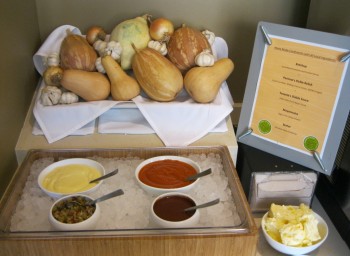
Eat Local Challenge 2011: Nourishing Guests, Communities, and the Environment
- Blog
How local can you go — food wise? That was the challenge taken up by dozens of Bon Appétit Management Company chefs in 31 states for the seventh annual Eat Local Challenge on Tuesday, September 27, 2011. Some cooked a meal from 99.9% local ingredients, with salt as the only allowable non-local ingredient. A few went 100% local — meaning they even foraged for salt from within 150 miles of the café. Others focused on serving one excellent local meal. The reasons to source local ingredients are simple but important if you care about sustainability: it tastes better, is more nutritious, encourages biodiversity, preserves open space, and protects the environment, just to name a few. The companywide Farm to Fork program has helped Bon Appétit accounts learn about what’s available in their area throughout the year, and how to use […]

Recipe: Linguine with Kale and Walnuts
- Blog
By Kristen Rasmussen, MS, RD For this month’s Well Being Challenge, we encourage you to provide your body with more nutrients and fiber and decrease your carbon footprint by enjoying more plant- based proteins. Demonstrate your commitment to increasing vegetable proteins in your diet by posting photos or comments about your plant-based protein meals and experiences on our Facebook page wall. Here’s a recipe to get you started. Linguine with Kale and Walnuts
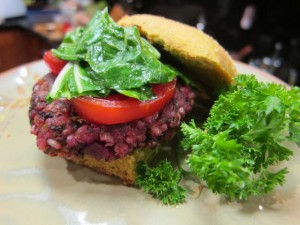
Recipe: Black Bean and Beet Burgers
- Blog
By Kristen Rasmussen, MS, RD For this month’s well being challenge, we encourage you to provide your body with more nutrients and fiber and decrease your carbon footprint by enjoying more plant- based proteins. Demonstrate your commitment to increasing vegetable proteins in your diet by posting photos or comments about your plant-based protein meals and experiences on our Facebook page wall. Here’s a delicious, unique recipe for you to try. Black Bean and Beet Burgers

Recipe: Bon Appétit at Nordstrom’s All-Local Scallops, Chard, and Farro
- Blog
The Eat Local Challenge has become one of my favorite celebrations each year. While many of our usual holidays come with prescribed dishes, such as turkey and stuffing for Thanksgiving, brisket and matzoh ball soup for Passover, and cookies topped with red and green sprinkles for Christmas, the Eat Local Challenge menu is always different — year to year, chef to chef, and region by region. The challenge is to create an whole menu where every ingredient (except for salt) comes from within 150 miles. While this is no easy task, I also find the challenge to be encouraging. Whether a chef or an eater, it encourages everyone to explore unusual flavors – found on our local farm and range lands and in our forests, lakes, and oceans, to learn about new producers, and tap into our inner creative spirit.
Employee Spotlight: Arthur Curtis, Making Wash U Folks Smile Every Day
- Blog
This video is the first in a series highlighting Bon Appétit employees across the country and the wonderful work they do. Here we are proud to introduce a man who brings a smile to countless faces every day—Arthur Curtis, line server at Bon Appétit at Washington University in St. Louis.
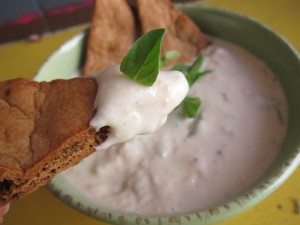
White Bean Hummus with Oregano
- Blog
By Kristen Rasmussen, MS, RD For this month’s well being challenge, we encourage you to provide your body with more nutrients and fiber and decrease your carbon footprint by enjoying more plant- based proteins. Demonstrate your commitment to increasing vegetable proteins in your diet by posting photos or comments about your plant-based protein meals and experiences on our Facebook page wall. This white bean hummus recipe s a great way to get started. White Bean Hummus with Oregano 1 can of white beans, drained and rinsed* 3-4 tablespoons tahini 1-2 tablespoons olive oil Juice from 1/2 lemon 1/2 -1 teaspoon salt 3 sprigs fresh or 1 teaspoon dried oregano *In Bon Appétit kitchens, menu items containing beans are made with cooked dry beans. You can substitute cooked dry beans for canned beans in your home as well. They may take longer to prepare, but have fresher […]
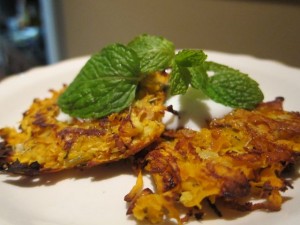
Baked Apple and Sweet Potato Latkes
- Blog
By Kristen Rasmussen, MS, RD For this month’s well being challenge, we encourage you to get to know your food – and where it comes from – by making meals with seasonalingredients from local producers. Demonstrate your commitment to the local food community by posting pictures or comments about your local and seasonal food experiences on our Facebook page wall. Here’s a recipe to get you started. Baked Apple & Sweet Potato Latkes Makes about twelve 2 – 3 inch latkes
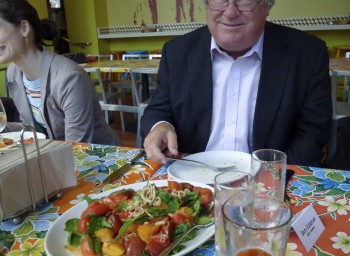
Done “Unripe and Unfair” Dinner with Barry Estabrook
- Blog
For the second dinner in our Eat With Bon Appétit series, we once again gathered at Mijita in San Francisco. This time, the guest of honor was Barry Estabrook, author of the new book Tomatoland: How Modern Industrial Agriculture Destroyed Our Most Alluring Fruit. The winner of a 2011 James Beard Award for his blog, Politics of the Plate, Barry has dug deep into the sterile, sandy soil of Florida’s tomato industry to reveal why most of the tomatoes Americans eat have no flavor and to illuminate the equally unsavory labor practices under which these rock-hard fruits are grown.
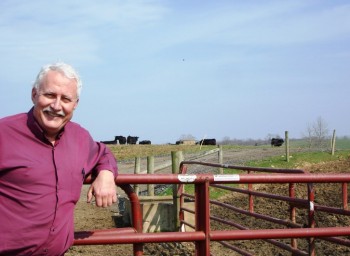
Grain-fed vs. grass-fed beef — and somewhere in between?
- Blog
Thanks to Michael Pollan‘s book The Omnivore’s Dilemma and the documentary Food, Inc., more people have become aware that the majority of cows in this country are raised on a grain-based diet for the last few months of their lives — and why that’s problematic for the health of the cows, the health of the humans who eat them, and the environment. The short version: Grains such as corn and soy are cheap carbohydrates that make cows get fat fast (not unlike humans). But cows’ digestive systems were designed to handle a high-fiber diet of mostly fresh grass or hay, with some natural grains. High-grain corn and soy diets — and the feedlots in which they are stuffed with them — cause many cattle to get sick, and encourage the prevalence of antibiotic-resistant E. coli as well. But as with […]
